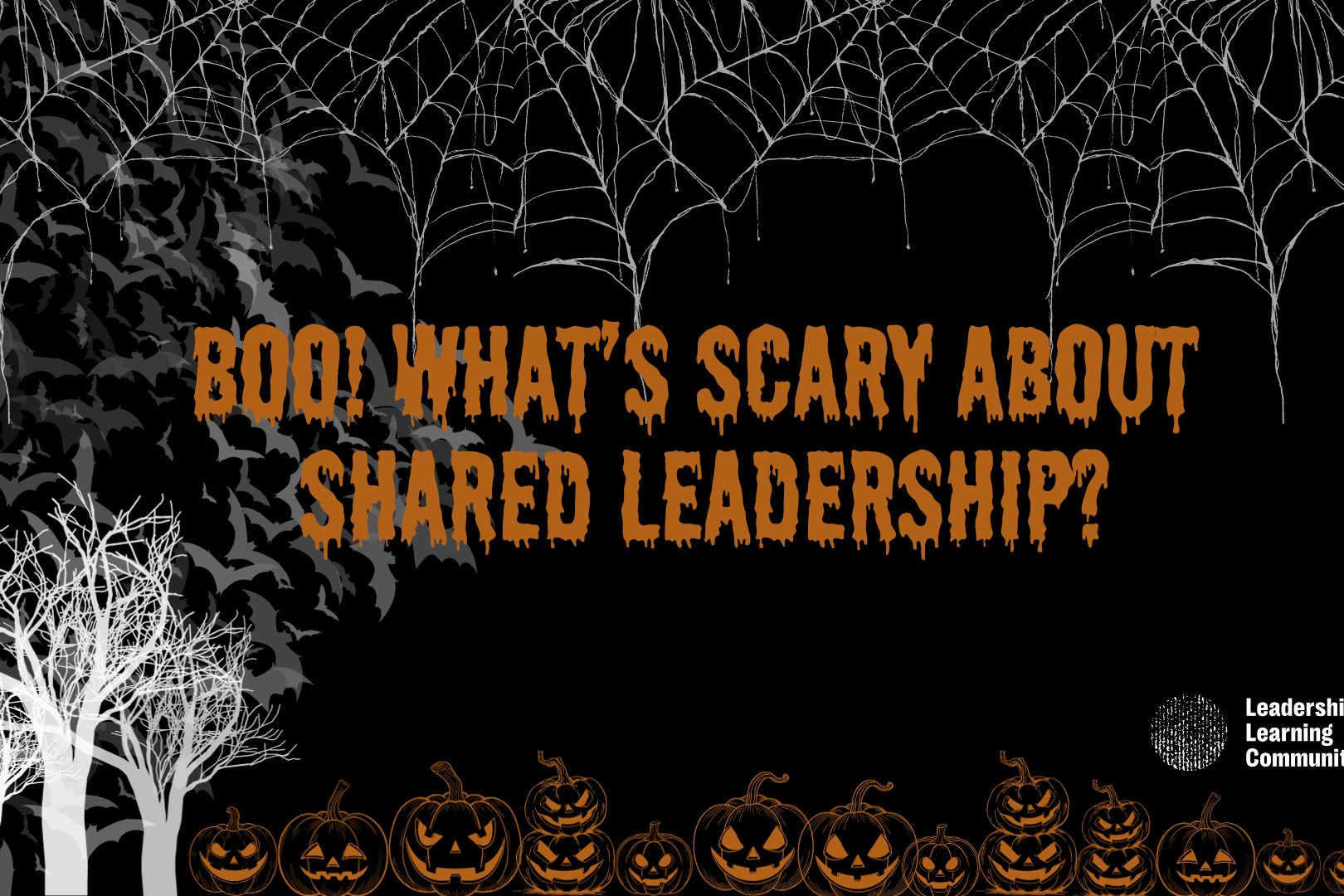We are fortunate to be a part of an organization with a core tenet of experimentation to explore and refine new practices for centering just and joyous ways of working together that align with our definition of Liberatory Leadership. One of the ways we are currently studying liberatory organizational practices is by slowly shifting our governance model to a more evenly distributed leadership model. As our co-EDs mentioned in the October 2023 blog – “When we say distributed leadership, we mean there is more leadership throughout the organization in that other positions are activated to contribute to decision-making with agency and power. It could be a reference to a totally flat organization, but it doesn’t have to be. Distributed leadership is a practice towards that end of the spectrum. Different organizations will need different leadership depending on what they do and where they are headed. For those who are headed towards equity and liberation, we believe that it’s worth exploring shared and distributed leadership models.”
This hands-on study began when the founder of LLC, Deborah Meehan, along with LLC’s Advisory Board, brought on Ericka Stallings as her co-ED. After Deborah transitioned out of her role, our organization deepened our exploration of distributed leadership with the hire of our current co-ED, Nikki Dinh, in January 2022. Over the past two years, we’ve had some bumps and successes, and we want to share some of the key learnings/experiences and some of the questions we are still wrestling with. We will continue to share more as we attempt to answer those questions internally and in partnership with other liberatory practitioners engaging in similar practices. In the October 2023 Blog, our co-EDs shared some of what works and what is scary from where they sit in the organization, and we wanted to share some of the Director-level experience of practicing distributed leadership.
Director-Level Experience of Practicing Distributed Leadership:
Before joining LLC, we both worked in various types of organizations and in multiple levels of the organizations, from Assistant/Coordinator to Manager to Director. We have all experienced these traditionally hierarchical organizations. There is plenty that comes with them that provides clarity on roles and expectations, and there also is a lot of opaqueness, uncertainty, and lack of autonomy that can reinforce oppressive societal stratifications and create great frustration. While our distributed leadership model is something we are building as we go, and the best next step can sometimes be unclear, the model, on the whole, feels like a breath of fresh air. An oxygenated space that opens the door to transparency, authentic collaboration, an increase in valued opinions, and opportunities for all members of the staff to practice leading/leadership.
Some of the largest foundational differences we have experienced in the way we are approaching distributed leadership as opposed to the other organizational models that we have been a part of before include:
- Transparency
LLC approaches all information-sharing decisions in the organization with a stance of maximizing transparency wherever possible, and then limiting access only to protect privacy and security as necessary. We’ve also created internal data-sharing protocols that transparently lay out for all staff the decision-making process and what types of information are being restricted. The result is that we’ve been able to diffuse some of the opaqueness while helping to foster an organizational culture of trust.
Practice:
- All members of the organization are invited to attend entire board meetings and have access to all materials shared with the board.
- Operating budgets, as well as Project/Program budgets, are shared with all staff along with supporting materials. Additionally, staff are given the opportunity to help co-create budgets for projects that they contribute to.
- Building Strategy Together
In traditional organization settings, we have had the experience of the overall strategy being decided by the top level of the organization and then shared with the rest of the team. Within the distributed leadership model, we built organizational strategy as a team through a process where our opinions held the same weight as our Co-EDs. We have not only been invited to participate in the co-creation process, but have also been encouraged to design and lead significant pieces of strategy development.
Practice:
- Developing our Learning Framework as a team. Engaging in an intentional process to ensure that the strategy aligns with the team’s thinking about the work.
- Encouraged to hold space to collaboratively build a strategy for our Work Circles in partnership with other circle leads.
- Holding strategy-focused Reflection Space for staff, and having the authority to shift direction on the reflection space as we felt necessary.
- Our co-EDs invited us to create and facilitate the retreat agenda, where we reflected on and interrogated our current work circle structure and held space for collective dreaming about our future work.
- Autonomy of Specific Projects
At LLC, we’ve purposely built a leaderful culture where staff are encouraged to try on and run with new ideas, tools, and processes. Staff are given the space to lead projects that they feel passionate about. Additionally, a learning stance that values the knowledge gained from failure as much as success reduces the fear of reprimand or negative repercussions from mistakes.
Practice: We do not automatically defer to the hierarchical position when deciding who will lead a specific project. Teams have conversations at the start of each project about roles within the project, and we identify the Pilot/Co-pilot and Contributors and the explicit actions of those roles within a particular project. These roles weigh natural strengths, capacity, and interest more than positional power.
Big Questions We Are Currently Holding About Distributed Leadership:
1. What is the right balance between love/healing/liberatory practice and accountability/rigor? Because we are creating liberatory practices as we go, and we don’t want to make the mistakes of past oppressive systems and practices, we may sometimes lean more towards the side of love and healing and away from traditional practices of accountability and rigor. In that shift, we can lose some clarity, effectiveness, and efficiencies that help us reach our project goals. There needs to be some exploration of how these two concepts are better balanced to move towards more expansive liberatory practices of accountability and rigor.
2. What are the appropriate mechanisms for communication and information sharing? For multiple levels of the organization to feel like they can lean into their leadership, there must be mechanisms for information sharing that result in shared awareness and understanding of the nuances of the work. Without this, it is easy for all staff members to default to hierarchical norms. We aren’t all in the same meetings or charged with holding the same things, and understandings and strategies can shift with a single one-off conversation. This can result in various levels of the organization hesitating to make significant decisions to ensure that they have all the information and can, by default, mean that decision-making and leadership power stays in one or two individuals. It can also be too much for everyone to know everything about each of the nuances of a particular project. Holding both things as valid means that there is work to do to understand all that a team member needs to know to feel empowered to lead while also being mindful of capacity, which is not easy.
3. How do we develop and implement explicit decision-making processes? It can sometimes take work to be clear who has final decision-making power. Beyond the structures and processes that we’ve already put in place, much of our decision-making success now is based on knowing each other well and being a small, responsible, and highly communicative team. Because we work well together, often, getting clarity can be easily solved with direct communication, or we have an implicit sense based on past patterns. And there are still times when shared leadership can lend itself to some need for clarity on who has final decision-making power in the traditional sense. We’ve made some steps in inputting some structure (e.g., Circle Leads and Pilot/Co-pilot model), and there is still room to be more explicit about our processes.
Supports/Structural Components That Make It Work
1. Consistent Reflection Space: Designated space in staff meetings where we reserve time for reflection, tough questions and feedback, and problem-solving conversations with all staff members. This intentional investigation allows for ease of honest communication. These spaces offer permission to have more difficult conversations that might otherwise be avoided.
2. Leadership Coaching For All: Our Co-EDs have monthly partnership coaching sessions. Our annual budget also has a standing line item for Leadership Coaches for each full-time staff member. Leadership coaching provides the support needed to increase capacity, and this investment in staff development further signals that deepened leadership at all levels is a true goal of the organization.
3. Core Values Embodied/Culture: Our observations of how the distributed leadership model plays out at LLC are clear examples of how many of our values regularly show up in our work culture. Learning and Experimentation are at the center, and because we are learning together, mistakes feel like opportunities, not failures. Collaboration and Interdependence are integral to our approach to the work; they are consistently demonstrated through the partnership of our Co-EDs, which serves as a model for how all of the staff shows up and shapes the overall culture of how we work together on teams.
4. Complementary Skill Sets: We’ve used strength assessments, exercises, and tools to understand and explicitly name our individual skill sets. All teammates are also encouraged to share their interests and the areas they hope to grow. With a shared understanding, we engage with various aspects of the work by leaning on the strengths of the collective team. We have complementary skill sets on our teams, which leaves room for members of the team to lead from their natural strengths as opposed to their positional power.
5. Governance structure: LLC is organized by four work circles: (1) Strategy/Development/Learning, (2) Liberatory Operations, (3) Liberatory Programs, and (4) Communications. A team member serves as the Circle Lead, but we intentionally consider these circles overlapping and regard the entire team as contributors to the work. Including multiple staff members on the committee of a given work circle is a key component of shared accountability and also means that there are more built-in opportunities for capacity building across the organization, as well as increased collaboration and information sharing.
Of course, through experiments like this one, we uncover aspects that work well, aspects we quickly realize just don’t work, and aspects we still have questions about and are exploring internally and in partnership with others to get more clarity. With all of this in play, the critical component that makes it all work well is that we consistently carve out space for individual and group reflection and feedback so that the experience of all levels of the organization can be incorporated into our future planning and become part of the practices and policies that we institutionalize. Even this is one example of distributed leadership. But most importantly, this reinforces an organizational culture where risk and vulnerability feel less dangerous because we know we are all learning and building together.
Are you exploring distributed leadership in your organization? Do you have learnings you want to share? Do you have any questions for us? We are always looking to deepen our organizational understanding and that of the field. Please reach out to us. We will also continue to share here.
Related Posts
October 24, 2023
Boo! What’s scary about shared and distributed leadership?
August 22, 2023
Oasis: LLC Culture
February 15, 2022




